Wavyleaf Purple Coneflower, Prairie Purple Coneflower, Glade Coneflower - Echinacea simulata
|
Echinacea simulata - Wavyleaf Purple Coneflower, Prairie Purple Coneflower, Glade Coneflower.
Echinacea is a small genus of 9 or 10 species closely related to Rudbeckia. All species of Echinacea are endemic to eastern and central North America.
Echinacea simulata has a relatively small distribution, with locations still being determined, since some populations of E. simulata being previously identified as E. pallida, with a primary diagnostic to determine the species being the color of the pollen - E. simulata has yellow pollen, while E. pallida has white pollen. The USDA map shown on this page is incorrect; it is not currently believed to be in North Carolina or Virginia, and there are reports that it is in Arkansas and Indiana. It is a plant of glades, prairies, and rocky open woodlands. The specimens here were photographed in Rutherford County, TN, in one of the few locations where it is known in the state. It is rare in Alabama, Georgia, and Tennessee.
The rootstock of Echinacea was used by Native Americans for a variety of ailments, and today commercial drugs and supplements include the species. The plant can be threatened by unscrupulous collectors who sell it to herbal medicine manufacturers. Do not collect the plant in the wild.
Found in:
AL, AR, GA, IL, IN, KY, MO, TN
Leave comments on Echinacea simulata at this link. | 
Distribution of Echinacea simulata in the United States and Canada:

Blue=Native; Grey=Introduced
Map from USDA Plants Database:
USDA, NRCS. 2017. The PLANTS Database (http://plants.usda.gov, 08 May 2025). National Plant Data Team, Greensboro, NC 27401-4901 USA.
Search Our Database: Enter any portion of the Scientific, Common Name, or both.
Do a general Google search of the entire site:
#ad
 Follow USWildflowers on Twitter
#ad
| | Site: Flat Rock Cedar Glades and Barrens State Natural Area, Rutherford County, TN Date: 2018-June-05 | Photographer: Gerald C. Williamson
Nikon D7000
Tamron SP 90MM f/2.8 AF Macro | | The pink to rosy purple (sometimes white, according to FNA) ray flowers of Prairie Purple Coneflower droop or are strongly reflexed. They are up to 3.5 inches long. | | 
| | Site: Flat Rock Cedar Glades and Barrens State Natural Area, Rutherford County, TN Date: 2018-June-05 | Photographer: Gerald C Williamson
Nikon D7000 | | The Echinacea simulata flower head is solitary at the top of a hairy stem, this one being visited by a pollinator, a bumblebee. The disc is a rounded cone shape. | | Click on the photo for a larger image
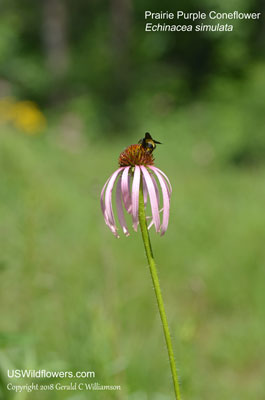
| | Site: Flat Rock Cedar Glades and Barrens State Natural Area, Rutherford County, TN Date: 2018-June-05 | Photographer: Gerald C Williamson
Nikon D7000 | | The pollen of the "perfect" (bisexual) disc flowers is yellow, a primary diagnostic to determine that this is Echinacea simulata rather than the extremely similar Echinacea pallida, which has white pollen. The drooping ray flowers are sterile. | | Click on the photo for a larger image
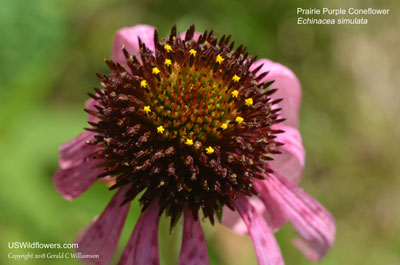
| | Site: Flat Rock Cedar Glades and Barrens State Natural Area, Rutherford County, TN Date: 2018-June-05 | Photographer: Gerald C Williamson
Nikon D7000 | | Prairie Purple Coneflower is a tall plant, carrying its solitary flower head atop a stem that may be 3 feet tall. The leaves are primarily basal, with a few leaves deployed alternately along the rough stem. The leaves may be up to 12 inches long and are usually less than 2 inches wide. | | Click on the photo for a larger image
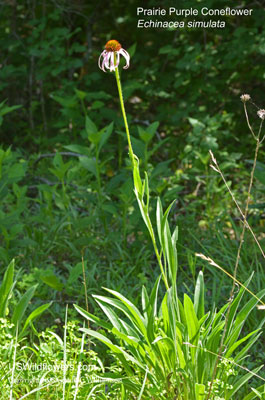
| | Site: Flat Rock Cedar Glades and Barrens State Natural Area, Rutherford County, TN Date: 2018-June-05 | Photographer: Gerald C Williamson
Nikon D7000 | | While rare and protected due to its limited distribution in Tennessee, the plant is plentiful in the few locations where it is found. Note the young flower with its uplifted rays - the early flower could be confused with another rare coneflower, Tennessee Coneflower (Echinacea tennesseensis). | | Click on the photo for a larger image
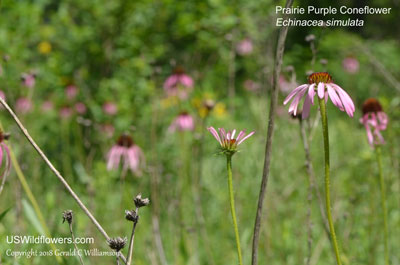
| | Site: Flat Rock Cedar Glades and Barrens State Natural Area, Rutherford County, TN Date: 2018-June-05 | Photographer: Gerald C Williamson | | The green stem, petioles, and leaves are coarsely hairy. The leaves are 3 to 5 veined. | | Click on the photo for a larger image
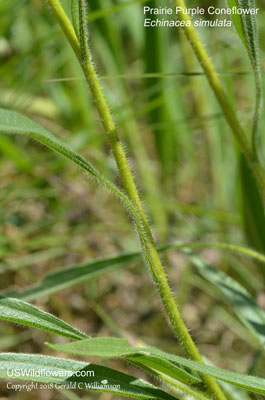
|
References used for identification and information:
|
|
| |
| #ad
|
|








